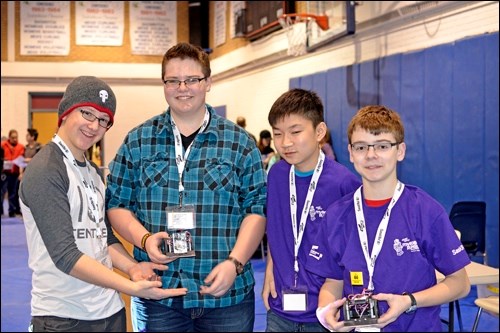Robotics have long been considered sci-fi characters from the future, however, in 2016, robotics are not only part of the present but are a new adventure for Unity Composite High School students.
Dallas Spendelow, Jordan Allen, Marco Sin and Dawson Jensen made up two teams supervised by Shawn Whyte. They began working on robots in January. Their goal was to attend the eight annual Robot Rumble held in Saskatoon April 14, hosted by the Saskatchewan Polytechnic’s School of Mining, Energy and Manufacturing. This year’s event hosted 53 schools, 124 teams and 230 student participants.
The Polytechnic supplies a robot kit with two robots to schools that participate. Other robots are allowed as long as they fit within a 10-centimetre cube and weigh no more than 500 grams. The robots are called SumoBots and the goal is for students to build and then program their robots to autonomously find their opponent and then push it out of the ring. Strategy comes from robot configuration, programming different behaviours and manoeuvres based on where the opponent is.
This was the first year of participation for UCHS.
“We all had to learn how to put these electronics together, and then configure and program them to win,” Whyte said.
“There were examples, but we had to tinker and play with the programming until we learned what types of code did what. There were some frustrations at times and sometimes we would go two or three practices before we figured out how to write a line of code that worked.”
At the competition, one robot — team Dreadnaught programmed by Marco and Dallas — placed second in its qualifying round, and then sixth in its semifinal round. Top three in each round progressed to finals. The second team (The Muppet Punchers programmed by Dawson and Jordan) had difficulties with its sensors and fell behind in the standings. They placed sixth in their qualifying round and were eliminated in the consolation round.
“In all, being our first year, we did spectacular,” says Whyte.
“We will be competing next year. We plan on looking for a new platform for the robot, maybe building our own, so we can be more of a threat next year.”
Dallas says, “Before the event, we got to practise the exact same way we would compete with a fold out paper of the competition that enabled us to practise as though we were really there.”
Dallas says he and his partner were confident they had done everything they could do to prepare for the experience.
“In between matches you could tweak minor things, but could not change the program,” he explains.
“We found our robots sluggish at times therefore adding batteries after every couple of matches made a difference. Our goal was to not finish last and we came out a lot better than that!”
Dallas says the teams will build on their experience for next year’s competition.
“ Now we know what it’s about, we can spend more time creating and designing.”




